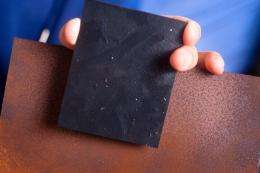Using graphene, scientists develop a less toxic way to rust-proof steel

(Phys.org) -- University at Buffalo researchers are making significant progress on rust-proofing steel using a graphene-based composite that could serve as a nontoxic alternative to coatings that contain hexavalent chromium, a probable carcinogen.
In the scientists' first experiments, pieces of steel coated with the high-tech varnish remained rust-free for only a few days when immersed continuously in saltwater, an environment that accelerates corrosion.
By adjusting the concentration and dispersion of graphene within the composite, the researchers increased to about a month the amount of time the treated steel can survive in brine. (Because brine is an extremely harsh environment, the coated steel's survival time in the real-world would be many times longer.)
The UB chemists leading the project are Sarbajit Banerjee, PhD, an assistant professor, and Robert Dennis, a PhD student. Their next step is to use a $50,000 grant from the New York State Pollution Prevention Institute to enhance the graphene composite's lasting power, as well as the quality of its finish.
Tata Steel, an international company that has provided past funding for Banerjee's projects, has been helping the scientists test larger sample sizes, Banerjee said.
Bringing the coating to the market could not only benefit public health, but also save jobs, said Dennis and Banerjee.
"Our product can be made to work with the existing hardware of many factories that specialize in chrome electroplating, including job shops in Western New York that grew around Bethlehem Steel," Banerjee said. "This could give factories a chance to reinvent themselves in a healthy way in a regulatory environment that is growing increasingly harsh when it comes to chromium pollution."
Graphene, the thinnest and strongest material known to man, consists of a single layer of carbon atoms linked in a honeycomb-like arrangement.
The material's hydrophobic and conductive properties may help prevent corrosion, repelling water and stunting electro-chemical reactions that transform iron into iron oxide, or rust, Banerjee said.

UB's Office of Science, Technology Transfer and Economic Outreach (STOR) has submitted a provisional patent application to protect the coating Banerjee and Dennis are refining. As sponsors of the research and due to inventive contribution by Tata employees, Tata Steel also has certain rights to the technology.
"Tata Steel has always displayed leadership in motivating innovative research and product development by leveraging partnerships with universities. UB has been one of our choices for cutting-edge coatings technology development on steel substrate," said Debashish Bhattacharjee, PhD, Tata Steel's group director for Research, Development and Technology.
"The development of an environmentally friendly alternative to hexavalent chromium would truly revolutionize this sector," said Anahita Williamson, PhD, director of the New York State Pollution Prevention Institute (NYSP2I), a research and technology transfer center funded by the New York State Department of Environmental Conservation. "The metals plating industry identified this as a high-priority research project and NYSP2I is excited to support UB researchers in their efforts to develop solutions."
The New York State Pollution Prevention Institute, headquartered at Rochester Institute of Technology (RIT), is a partnership between RIT, Clarkson University, Rensselaer Polytechnic Institute, UB and the state's network of Regional Technology Development Centers.
Provided by University at Buffalo


















